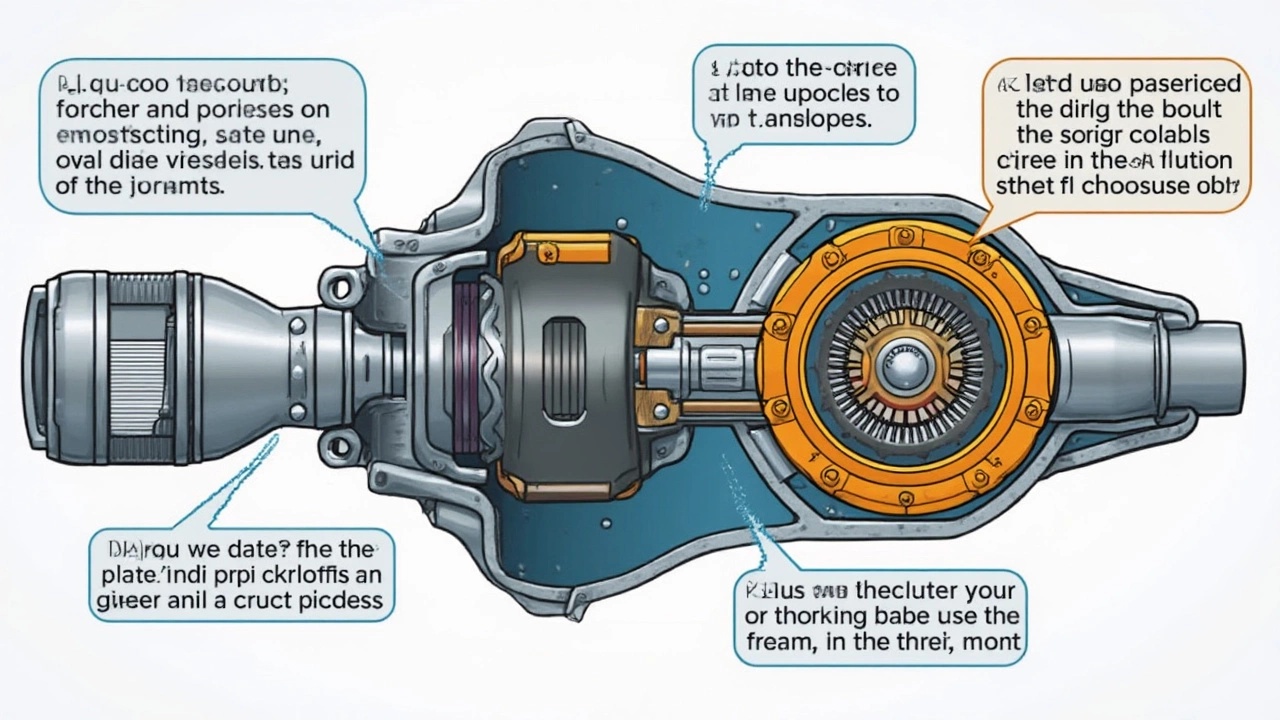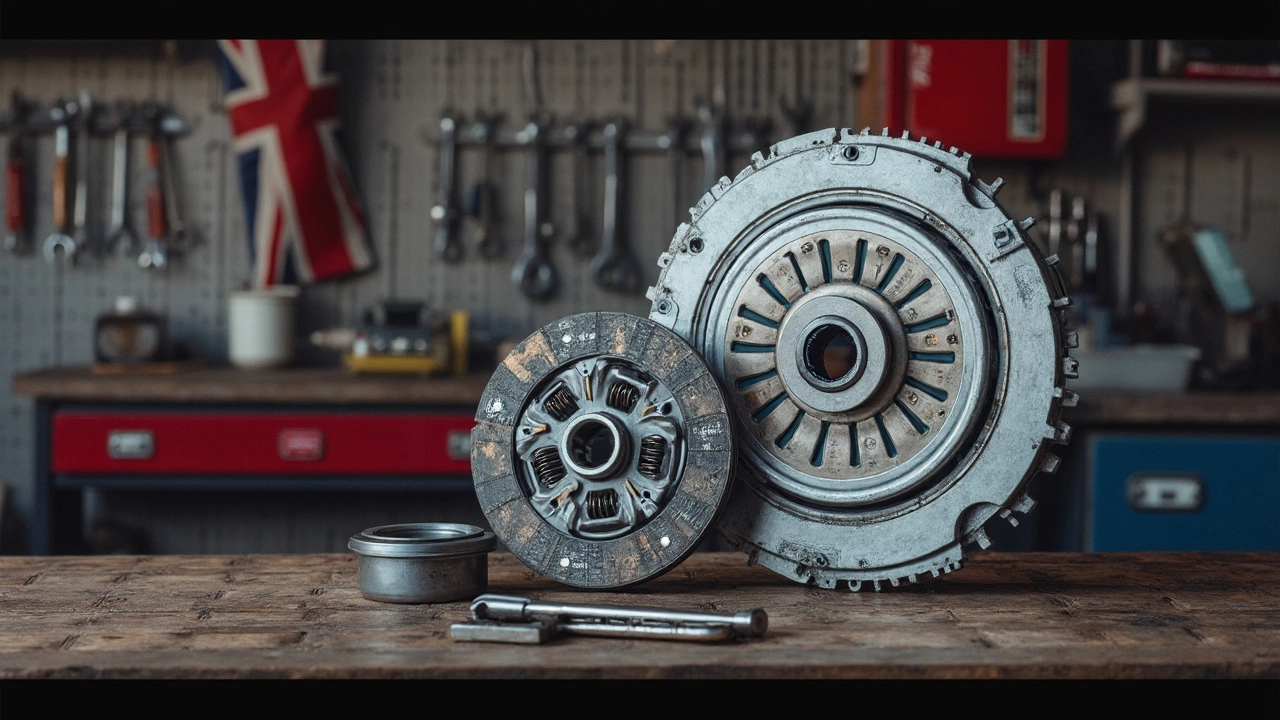Ever looked at a clutch kit box and wondered what you’re actually getting for your money? If you're facing clutch problems, knowing what's in a full kit can save you money, time, and a ton of headaches at the mechanic. It's more than just a clutch disc—there are some key parts in there you really can't skip.
The basics usually include the clutch disc, a pressure plate, and a release bearing. But on some cars, you'll also get a pilot bearing or bushing, an alignment tool, and maybe even some fresh hardware. It’s not just random stuff thrown together—each piece has a job, and skimping on any of them can mess up your repair.
If you just swap the clutch disc and ignore the rest, odds are the job won’t last. That’s why most shops (and anyone who’s done this job twice) recommend going for the full kit. It’s not just about fixing what’s broken; it’s about making sure your clutch works smooth for miles to come.
- The Main Parts in a Full Clutch Kit
- How Clutch Kit Parts Work Together
- Why You Need Every Part
- Tips for Picking and Installing a Clutch Kit
The Main Parts in a Full Clutch Kit
If you crack open a clutch kit box, you’ll find a handful of crucial parts. Each one plays a key role in making your car shift smoothly without any weird noises, slipping, or jerking. Let’s break down what you actually get.
- Clutch Disc: This is the heart of the kit. The clutch disc connects your engine to your transmission. It’s covered in friction material, kind of like brake pads, and this is what wears out and makes your clutch slip.
- Pressure Plate: The pressure plate sits on top of the clutch disc and clamps it against the flywheel. It’s what helps transfer engine power to the wheels and lets you disengage the clutch when you press the pedal. Over time, it can lose clamping force or the springs can get weak, which messes up shifting.
- Release Bearing (or Throw-out Bearing): This bearing presses against the pressure plate every time you push the clutch pedal. If it’s noisy or rough, it can make your clutch pedal feel bad or even damage other parts. Always replace this part—it’s cheap insurance.
- Pilot Bearing or Bushing: Not every car has one, but if yours does, don’t ignore it. The pilot bearing helps support the transmission input shaft, so everything lines up and spins smoothly. A bad one can make a horrible squeal and even cause vibration.
- Alignment Tool: This little plastic or metal rod might seem like a throwaway, but try lining up your clutch without it. Nearly impossible. It lines up the clutch disc with the pilot bearing, so the transmission slides back in easily.
- Hardware: Some kits include new bolts or screws. Not all, but if they’re in there, use them. Old hardware can snap or strip threads. Nobody wants extra drama during installation.
A lot of drivers only think about the clutch disc, but all these parts work together as a team. Going half-way usually means you’ll be under the car again way sooner than you’d like. Also, most quality clutch kits are made to fit certain cars—mixing and matching usually leads to trouble.
| Part | Common Failure Symptoms |
|---|---|
| Clutch Disc | Slipping, burning smell, chattering when moving off |
| Pressure Plate | Hard shifting, pedal feels heavy/stiff, clutch not disengaging |
| Release Bearing | Noisy clutch pedal, rattling or squealing during operation |
| Pilot Bearing/Bushing | Noise when clutch is engaged, difficult gear changes |
If you’re shopping for a clutch kit or thinking about a clutch replacement, double-check the kit’s contents for your car model. Missing a small part can turn a weekend job into a drawn-out hassle.
How Clutch Kit Parts Work Together
Every part in a clutch kit sits right at the heart of how a manual transmission does its thing. The cool part is how these bits play off each other to get power from the engine to the wheels, and still let you shift gears without grinding metal or yanking your arm off the shifter.
Here’s the lowdown on how it all flows:
- Clutch Disc: This is the friction plate that gets held between the flywheel and pressure plate. When you press the clutch pedal, the disc moves away from the flywheel, which disconnects the engine from the transmission so you can shift gears.
- Pressure Plate: Think of this as a big spring-loaded clamp. It presses the clutch disc up against the flywheel when your foot is off the pedal, letting power flow. Pushing the pedal releases pressure, creating that separation you need to switch gears smoothly.
- Release Bearing (Throwout Bearing): This bearing slides into action every time you step on the clutch pedal. It pushes against the pressure plate’s release fingers, loosening the clamp so the clutch disc can spin free.
- Pilot Bearing or Bushing: Not every car has this, but if yours does, it sits inside the end of the crankshaft. It supports the input shaft of the transmission, keeping everything lined up while your engine’s spinning.
When you nail that perfect shift, it’s because each part in the clutch kit did its job. The clutch disc slips just enough, the pressure plate lets go at the right moment, and the release bearing makes it smooth — no jerks, no clunks. If even one piece in this system’s worn out, you’ll feel it in weird pedal feedback, slipping, or rough shifts.
Want a quick look at what happens when you hit the pedal? Check this out:
| Pedal Position | Action | Result |
|---|---|---|
| Pedal Up | Pressure plate clamps clutch disc | Power flows to transmission |
| Pedal Down | Release bearing pushes pressure plate fingers | Clutch disc releases, gears can change |
Getting the whole clutch kit replaced at once makes sure these interactions all happen just like they should, cutting down wear, nasty noises, and the risk of paying again for labor next year.

Why You Need Every Part
If you’ve ever thought about replacing just one piece from your clutch kit to save a few bucks, hold up. Every part in the kit is there for a reason, and skipping anything is asking for trouble down the road.
The clutch disc grabs and releases the flywheel to get your car moving. If it’s worn, you get slippage, jerky engagement, or even a car that just won’t go. That’s the part everyone notices, but it doesn’t do the job alone. The pressure plate gives the disc the squeeze it needs. If it’s weak or warped, your new disc won’t have a chance to do its job properly.
Then there’s the release bearing—also called a throw-out bearing. This little piece sits between your clutch pedal setup and the pressure plate. If you reuse an old bearing, you might put in all that work only to hear annoying squeaks or grinding noises every time you depress the clutch. Worse, a failing release bearing can lead to a clutch that simply won’t disengage.
The pilot bearing or bushing isn’t always in every car, but on most manuals it keeps the transmission input shaft spinning straight. Skip it, and you risk vibrations, rough shifts, or abnormal wear on your shiny new clutch components.
- Alignment tool: Makes sure your disc lines up right with the flywheel so you don’t waste hours fighting your transmission back onto the motor. It’s simple but critical.
- Fresh hardware: Old bolts can stretch or corrode. New ones help keep everything tight and safe. Some kits include them, some don’t—double check before starting your job.
There’s a real-world reason mechanics push for a full clutch replacement and not piecemeal repairs: It cuts down on repeat jobs. A 2023 industry survey showed that shops who used full clutch kits had to redo only 7% of their jobs within a year—compared to 22% when just swapping individual bits.
| Part | Risk If Skipped |
|---|---|
| Clutch Disc | Slipping, burned flywheel |
| Pressure Plate | Poor engagement, shuddering |
| Release Bearing | Noisy clutch, hard shifting |
| Pilot Bearing | Input shaft wobble, rough shifting |
| Alignment Tool | Misaligned install, wasted time |
| Fresh Hardware | Loose parts, safety risk |
Bottom line: skimping on parts almost always means double labor later. Full kits are about doing the job once and driving worry-free.
Tips for Picking and Installing a Clutch Kit
Choosing the right clutch kit can feel like a maze, especially with all the options out there. The biggest mistake? Just grabbing the cheapest kit or whatever happens to be sitting on the shelf. Your clutch links your engine to your wheels, and if it’s not right, you’ll feel it every single time you change gears.
First thing, check your car’s specs. Make sure you’re buying a kit for your exact make, model, and year. Performance clutches might sound flashy, but unless you’re racing or towing heavy stuff, stick to OEM or a reputable aftermarket brand. Avoid off-brand kits from sketchy sellers online—cheap parts can mean a second round of labor in just a few months.
- Always get a complete clutch replacement kit, not just the disc or plate.
- Check reviews for real-world feedback—some brands have known issues with premature wear or noisy bearings.
- If your flywheel is showing cracks or deep grooves, resurface or replace it. It’ll bite back if you ignore it.
Planning to install it yourself? It’s doable with the right tools and patience, but it’s not a job for total beginners. Lifting the transmission is tough, and one slip-up (like not using the clutch alignment tool) can mean you’re doing it all over again. Many folks forget to replace the pilot bearing and think it’ll be fine—it almost never is. Do the job once, do it right.
- Use the provided alignment tool so the clutch disc doesn’t shift during install.
- Torque all bolts to spec; overtightening can warp the new pressure plate.
- Clean the new parts with brake cleaner before installation. Old oil or grease ruins friction fast.
- Bleed the clutch system (for hydraulics) after install to avoid spongy pedals.
It’s smart to check for extras in your kit. Good kits sometimes give you fresh hardware, which can be lifesaving if those old bolts are rusted or stripped. And don’t forget to follow the break-in procedure—usually about 500 miles of easy driving—so your new clutch components seat properly.
| Install Time Estimate | Skill Level | Potential Cost (USD) |
|---|---|---|
| DIY: 5-8 hours | Intermediate/Experienced | $200 - $500 for parts |
| Shop: 2-4 hours | Professional Mechanic | $800 - $1,200 (parts & labor) |
The right kit and a careful install can make your next clutch replacement last 60,000 to 100,000 miles. Don’t rush it—it’s better to double-check than to get stuck with a slipping clutch all over again.

